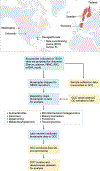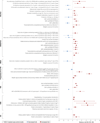Looking back at the TEDDY study: lessons and future directions
- PMID: 39496810
- PMCID: PMC11825287
- DOI: 10.1038/s41574-024-01045-0
Looking back at the TEDDY study: lessons and future directions
Abstract
The goal of the TEDDY (The Environmental Determinants of Diabetes in the Young) study is to elucidate factors leading to the initiation of islet autoimmunity (first primary outcome) and those related to progression to type 1 diabetes mellitus (T1DM; second primary outcome). This Review outlines the key findings so far, particularly related to the first primary outcome. The background, history and organization of the study are discussed. Recruitment and follow-up (from age 4 months to 15 years) of 8,667 children showed high retention and compliance. End points of the presence of autoantibodies against insulin, GAD65, IA-2 and ZnT8 revealed the HLA-associated early appearance of insulin autoantibodies (1-3 years of age) and the later appearance of GAD65 autoantibodies. Competing autoantibodies against tissue transglutaminase (marking coeliac disease autoimmunity) also appeared early (2-4 years). Genetic and environmental factors, including enterovirus infection and gastroenteritis, support mechanistic differences underlying one phenotype of autoimmunity against insulin and another against GAD65. Infant growth and both probiotics and high protein intake affect the two phenotypes differently, as do serious life events during pregnancy. As the end of the TEDDY sampling phase is approaching, major omics approaches are in progress to further dissect the mechanisms that might explain the two possible endotypes of T1DM.
© 2024. Springer Nature Limited.
Conflict of interest statement
Competing interests: The authors declare no competing interests.
Figures




References
Publication types
MeSH terms
Substances
Grants and funding
- U01 DK063821/DK/NIDDK NIH HHS/United States
- UC4 DK063863/DK/NIDDK NIH HHS/United States
- UL1 TR002535/TR/NCATS NIH HHS/United States
- HHSN267200700014C/DK/NIDDK NIH HHS/United States
- U01 DK128847/DK/NIDDK NIH HHS/United States
- U01 DK063790/DK/NIDDK NIH HHS/United States
- UL1 TR000064/TR/NCATS NIH HHS/United States
- U01 DK063836/DK/NIDDK NIH HHS/United States
- U01 DK063829/DK/NIDDK NIH HHS/United States
- U01 DK063865/DK/NIDDK NIH HHS/United States
- UC4 DK095300/DK/NIDDK NIH HHS/United States
- UC4 DK063861/DK/NIDDK NIH HHS/United States
- UC4 DK063829/DK/NIDDK NIH HHS/United States
- UC4 DK063821/DK/NIDDK NIH HHS/United States
- UC4 DK117483/DK/NIDDK NIH HHS/United States
- UC4 DK063836/DK/NIDDK NIH HHS/United States
- UC4 DK112243/DK/NIDDK NIH HHS/United States
- U01 DK124166/DK/NIDDK NIH HHS/United States
- U01 DK063861/DK/NIDDK NIH HHS/United States
- UC4 DK063865/DK/NIDDK NIH HHS/United States
- U01 DK063863/DK/NIDDK NIH HHS/United States
- UC4 DK106955/DK/NIDDK NIH HHS/United States
- UC4 DK100238/DK/NIDDK NIH HHS/United States
LinkOut - more resources
Full Text Sources
Medical
Research Materials

